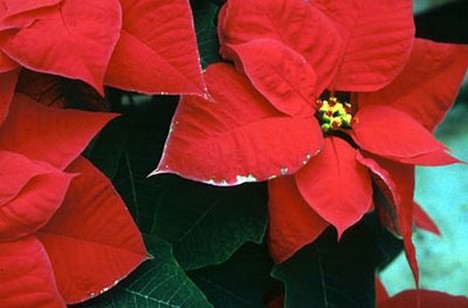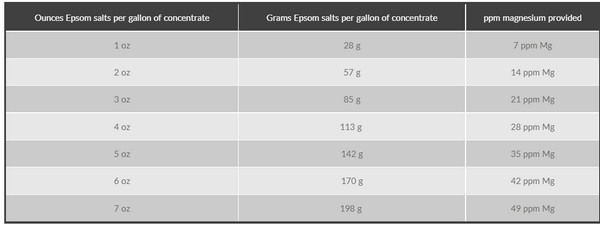Poinsettias are a crop grown for the Christmas season. It is a longer crop than most grown in the greenhouse, so that it can come with additional challenges.
One of these challenges is fertilization. This article presents guidelines on the important elements that poinsettias need, as well as application rates depending on the stage of plant development.
Selecting the proper fertilizer
Before selecting fertilizer(s) for your poinsettia crop, test the water. The fertilizer program should consider the alkalinity of the water, as it has a major influence on the growing medium's pH.
 Poinsettia crop that has been properly cared for. Source: Premier Tech
Poinsettia crop that has been properly cared for. Source: Premier Tech
If the alkalinity is high, acid needs to be injected into the water to bring it down to acceptable levels, thereby minimizing high pH problems in the growing medium.
A water test also measures the number of beneficial nutrients in the water, such as calcium, magnesium, and sulfate. If these elements are missing, the results will dictate the need for supplemental fertilizers. Water can also supply problematic amounts of sodium, chloride, or fluoride that may influence leaching frequency.
Experts also suggest using fertilizers with higher levels of nitrate to grow a toned plant instead of higher ratios of ammonium that can cause stretching. Remember that higher levels of phosphorus (more than 30 ppm P) have been found to cause more stretching than ammonium.
Be cautious, as fertilizers with higher ratios of nitrate vs. ammonium are usually "potentially basic" and will cause the pH of the growing medium to rise.
If higher nitrate fertilizers are used, more acid may need to be injected into the water to offset potential increases in the growing medium's pH.
What to consider when selecting a fertilizer
Most fertilizers are not formulated with sufficient calcium, magnesium, and possibly molybdenum for the needs of most poinsettias. Thus, there is typically more than one fertilizer used for a poinsettia crop. Before selecting a fertilizer, look at your water analysis, as your water may have sufficient calcium and/or magnesium to bridge the gap.
There should be a constant application rate of at least 80-100 ppm calcium and 35-50 ppm magnesium, and the growing medium should have 100-200 ppm calcium and 30-80 ppm magnesium throughout the crop cycle.
If the water source does not have sufficient calcium, then a cal-mag fertilizer can be used (keep in mind this will cause the growing medium's pH to rise). If this is not sufficient, then 15-0-15 could be rotated with another acidic fertilizer.
Growers have also used calcium nitrate foliar feeds at rates of 300-400 ppm nitrogen once per week. Calcium application is most critical during bract formation as they are most sensitive to bract edge burn, which is often caused by calcium deficiency.
Keep in mind that calcium uptake from the growing medium might be compromised when the humidity in the greenhouse is high, and the weather is cloudy, so foliar feeds may be more beneficial.

Bract edge burn on poinsettia caused by calcium deficiency. Source: Premier Tech
Extra magnesium can be supplied with a cal-mag fertilizer or by using Epsom salts. Epsom salts can be mixed with most fertilizers that do not contain calcium or can be applied at higher rates once per week. See Table 1 for application rates of Epsom salts when applied at an injection ratio of 1:100.
Molybdenum should be applied at a constant rate of 0.1 ppm. If more is needed, ammonium molybdate can be provided at rates posted in Table 2.

Table 1. Application rates in the third column assume that the ounces of fertilizer listed in the first column or grams listed in the second column are diluted into one gallon of fertilizer concentrate and injected with a fertilizer injector at a ratio of 1:100.

Table 2. Application rates in the third column assume that the ounces of fertilizer listed in the first column or grams listed in the second column are diluted into one gallon of fertilizer concentrate and injected with a fertilizer injector at a ratio of 1:100. Because so little molybdenum is needed, it has been suggested to take 1 oz ammonium molybdate, dissolve it into 40 oz of water, then take 0.15 oz of this solution and add it to each gallon of fertilizer stock solution and inject at 1:100.
Application rates in relation to the growth stage of the plant
Cutting stage
When unrooted cuttings are stuck, they are placed under mist until root development occurs. Misting will leach any starter fertilizer if any, that may be present in a growing medium.
Once cuttings begin callusing, it is recommended to apply 125 ppm nitrogen from a balanced fertilizer once per day after the mist is turned off in the evening. This will replenish fertilizer levels, so it is available to the cuttings when roots begin to form.
As roots develop, misting frequency is greatly reduced or discontinued. Fertilizer application rates can increase to 150 ppm nitrogen and should be applied at every watering until rooted cuttings are transplanted into larger containers.
Remember: if rooted cuttings are crowded in trays, luxury amounts of fertilizer can cause additional stretching in poinsettia cuttings. Make sure that the electrical conductivity (E.C.), a measure of the total salts coming from fertilizer, water, and injected acid, is 1.0-1.8 mmhos/cm (based on the saturated media extract (S.M.E.) test method) and pH between 5.5-6.0.
Active growing stage
This stage occurs after rooted cuttings are transplanted and continues up to the beginning of flower initiation. During this time, poinsettias grow at their fastest rate and therefore require the highest rate of fertility. Most experts suggest feeding poinsettias on a constant basis at 200-250 ppm nitrogen. However, some growers may prefer feeding once per week at 350-400 ppm nitrogen.
Faster growing, light green leaf varieties typically require higher application rates, whereas the more popular, slower growing dark leaf varieties require lower application rates. Based on the saturated media extract, the growing medium's pH should be maintained between 5.6-6.2, and the E.C. between 1.5 and 2.5 mmhos/cm.
If any nutrient deficiencies occur during this growth phase, they should be corrected as fertilizer application rates decrease once flower initiation begins. With reduced rates, there is less fertilizer available in the growing medium to address nutrient deficiencies.
Flower initiation and bract coloring
This stage usually begins in mid to late October and is accompanied by slower plant growth. Fertilizer needs of poinsettias also decrease, so it is best to reduce constant feed rates to 75-100 ppm nitrogen.
If the fertilizer application rate is not reduced, fertilizer salts can quickly build up in the growing medium. Excess salts can burn poinsettia roots, allowing for Pythium or other fungal pathogens to infect the root system.
The nitrogen application rate may need to be adjusted depending on the E.C. of the growing medium. The E.C. should be 0.8-1.5 mmhos/cm, and pH between 5.6 and 6.2. Calcium application is critical as low levels of calcium can cause bract edge burn.
Some experts suggest eliminating fertilization in the last 2-3 weeks before shipping, but this depletes all nutrient reserves and can lead to nutrient deficiencies. It is better to apply a low rate of fertilizer up to shipping than none.
Monitoring and testing to verify
As with any greenhouse crop, it is best to do weekly in-house testing of the pH and E.C. of the growing medium. This will help identify potential problems before they occur. Not all cultivars have to be tested but select a light green and dark green cultivar to monitor.
Select plants for monitoring from different container sizes and different planting dates. It is also advisable to send media and tissue samples to a horticultural laboratory once per month to monitor all nutrient levels. Even when growing with a normal pH and E.C., there could still be a deficiency or toxicity of a single element.
For more information: Premier Tech
Premier Tech
www.premiertech.com
